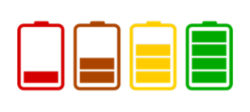The Definitive Guide for K-12 Classroom Device Deployment
Chapter 4: Technology Classroom Setup
Create a Research and Development Team
Yes- we are back on this topic. When you are setting up your classrooms or even virtual spaces, consider first the intended learning outcomes. How will you achieve those outcomes within your environment? You picked your student device, so the next step is to build a team to design the peripherals that interface with the student device. Create small pilots and get teacher/student feedback. This will aide in the success of implementation and communication.
Classroom
 As learners evolve, so should effective methods of teaching. Modern classrooms are evidence of this transformation. You may see displays in a classroom used for mini-lessons, but today you will find that teachers can instruct through their device so all students are seeing content displayed on their own device. We are moving away from direct instruction to more collaborative groups. Do you need smaller displays for collaborative grouping? Here are additional questions you may want to consider.
As learners evolve, so should effective methods of teaching. Modern classrooms are evidence of this transformation. You may see displays in a classroom used for mini-lessons, but today you will find that teachers can instruct through their device so all students are seeing content displayed on their own device. We are moving away from direct instruction to more collaborative groups. Do you need smaller displays for collaborative grouping? Here are additional questions you may want to consider.
• Do teachers need an interactive board?
• Do students/teachers have touchscreen devices; if so, is it necessary?
• How will teachers and students connect/mirror their devices to the display? Audio and video are huge factors.
• Is a document camera needed? Web cam?
• Do you have an audio/mic system? How will that interface?
• Are wireless keyboards/mice needed? Batteries?
Additional Technology for Virtual/Blended Learning
If you are setting up a hybrid or virtual environment, you may be considering technology that will enhance synchronous sessions with your students. A document camera will support visuals of physical items, a good headset with a microphone will support audio quality. If you are teaching simultaneously with a group of students online and a group in person, consider a clip on microphone and webcam that can pick up your movement.
Transitions in the Classroom
Once you have the correct technology and teachers trained and empowered for when and how to use it, consider how it will physically flow within the classroom. The goal is for technology not to be the afterthought or a hassle for learning; the goal is for technology to seamlessly support learning. Consider how easy it will be for students to access devices when used for an activity, or when they return from their breaks, lunch, recess, or other classes.
• Are the devices visible at all times to students, or are they locked away out of sight?
• Are the students empowered to access these devices on their own, or is the technology controlled by the teacher?
• How much does the transition to using devices cut into learning time?
• Do students of all ages and abilities have the same opportunity to access their device?
Contingency Plans for Uncharged Devices
 If devices are charged at home, or using a cart in the classroom, there will always be occasions where devices are accidentally not charged. Ideally this is avoided on the front end with highly responsible students or exceptional charging cart design. But when the inevitable happens, what’s the back-up plan so learning is uninterrupted?
If devices are charged at home, or using a cart in the classroom, there will always be occasions where devices are accidentally not charged. Ideally this is avoided on the front end with highly responsible students or exceptional charging cart design. But when the inevitable happens, what’s the back-up plan so learning is uninterrupted?
